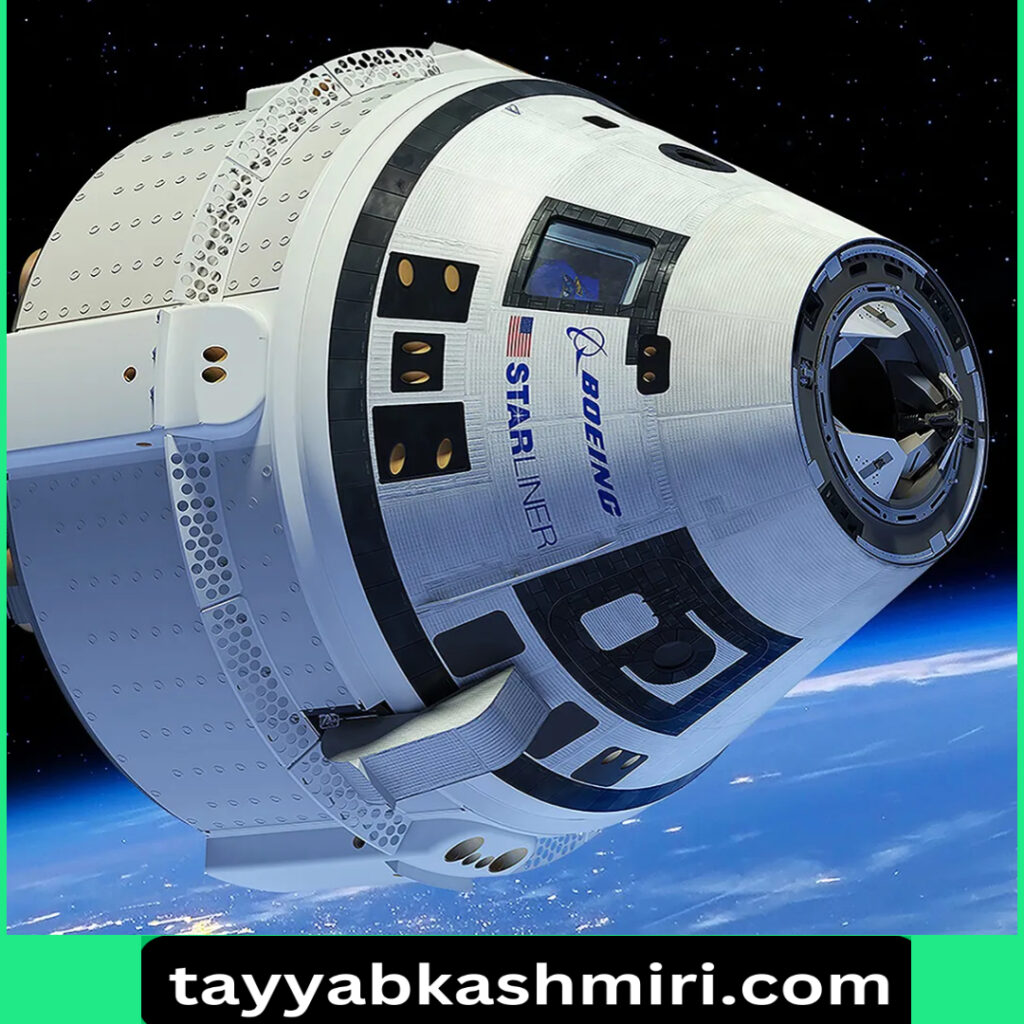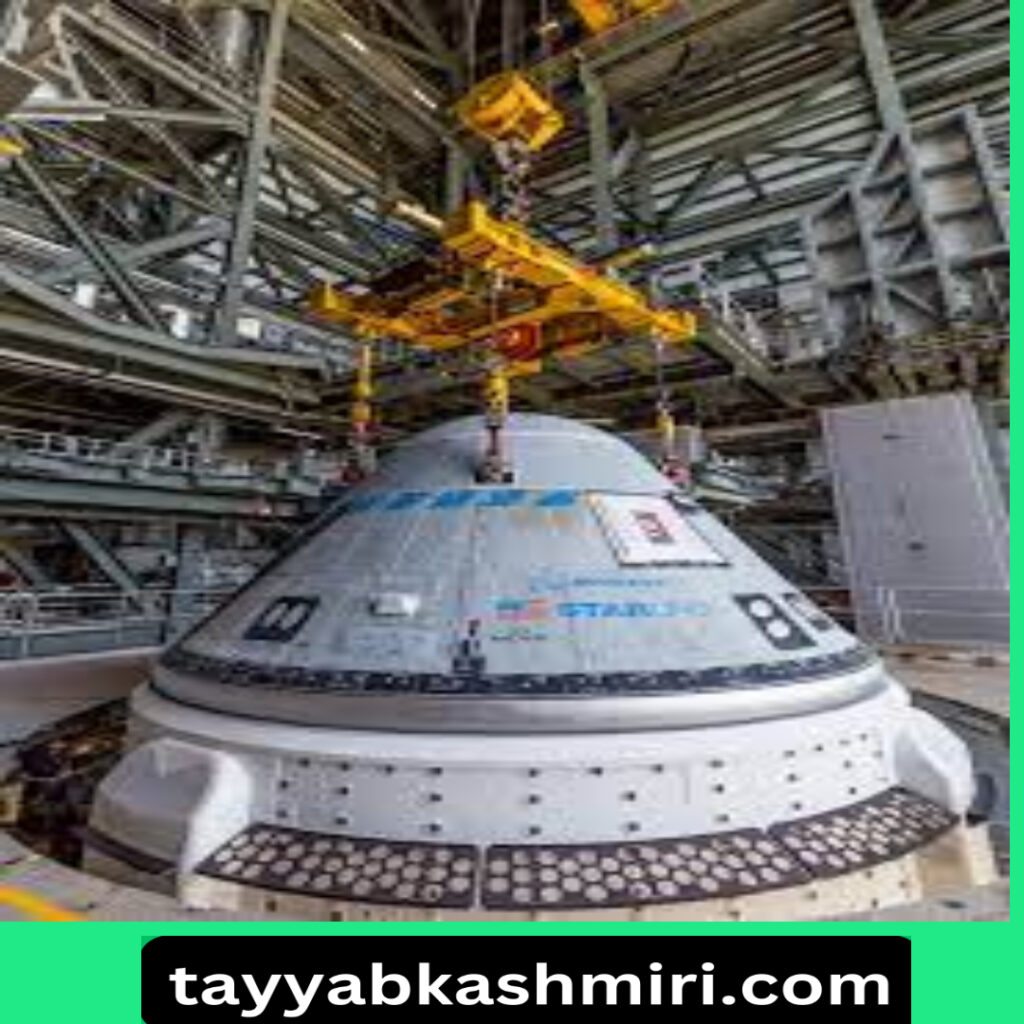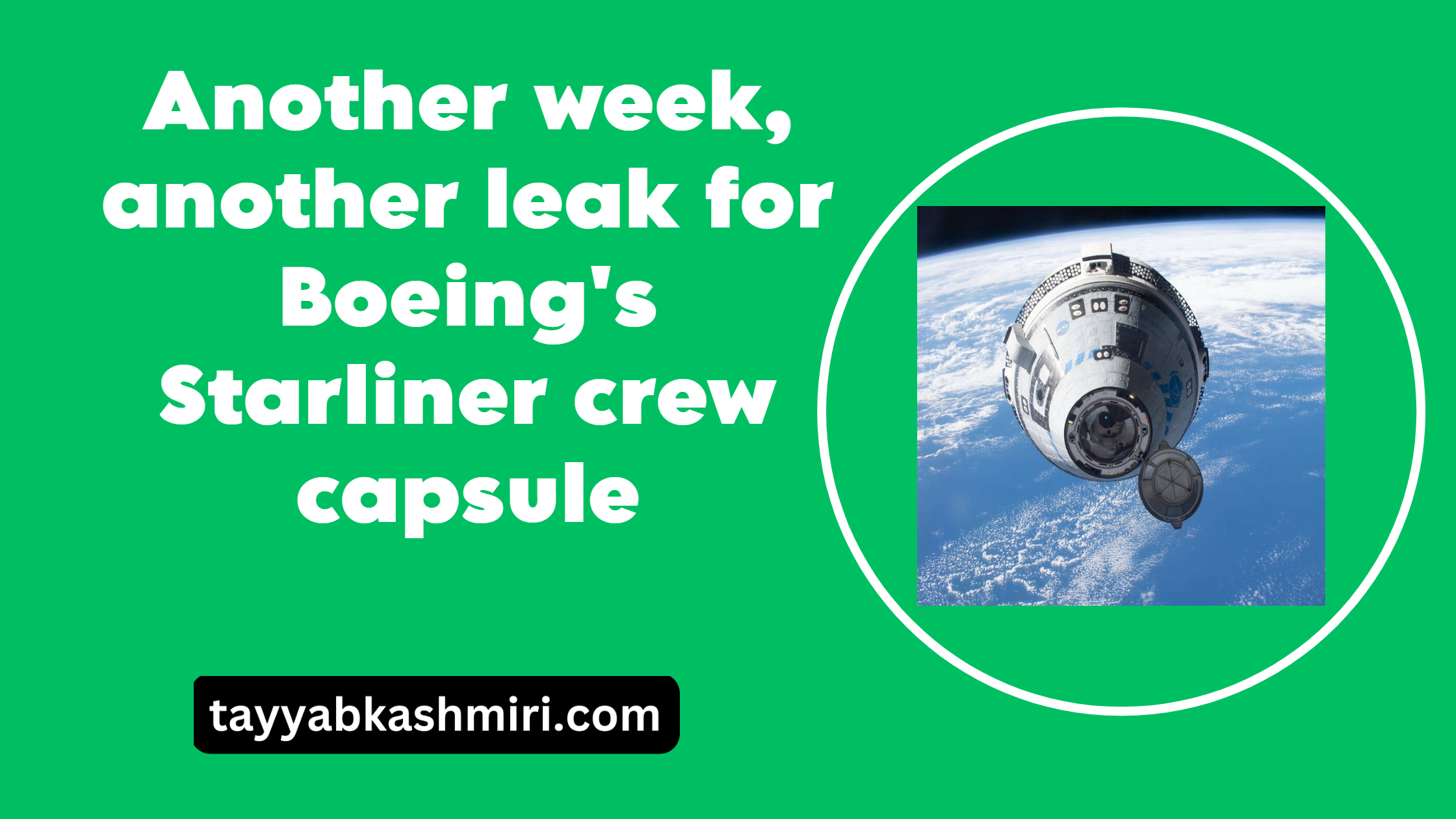Another week, another leak for Boeing’s Starliner crew capsule
Table of Contents
For More Articles : Visit Here
Boeing’s Starliner crew capsule
Boeing’s Starliner spacecraft has encountered yet another leak during testing, further delaying the company’s plans to launch astronauts to the International Space Station. Get the full details on this latest setback and what it means for Starliner’s future.
For Boeing and its troubled Starliner spacecraft, the hits just keep on coming. On the heels of multiple previous leaks, stuck valves, software errors, and a failed uncrewed orbital flight test in 2019, the company has now confirmed a new leak in Starliner’s propulsion system during recent testing.
The fresh setback comes as Boeing races to resolve a long litany of issues and prove the crew capsule is finally ready for its first crewed mission to the International Space Station (ISS) later this year. However, this latest leak has prompted more scrutiny and doubts about whether Starliner will be cleared to fly astronauts in the near future as planned.
The Constant Leak Saga Continues

During routine pre-launch preparations on June 14th at NASA’s Kennedy Space Center in Florida, Boeing engineers detected signs of a potential leak while loading propellant into Starliner’s propulsion system. Further troubleshooting confirmed a leak in the component responsible for initiating the firing of the capsule’s abort engines, which are critical for propelling the spacecraft away from its rocket in the event of an emergency during launch.
The source of the leak remains under investigation, though Boeing has ruled out any issues with the valves themselves this time around. That marks a change from earlier this year when sticky oxidizer valves prevented Starliner from achieving the proper internal pressures needed for test flights.
In a statement, Boeing acknowledged the latest leak but downplayed its significance, stating that resolving it is “well within the scope of previous and already completed testing.” The company is working methodically through troubleshooting alongside NASA and hopes to determine a root cause soon.
However, outside observers view the leak as anything but a minor issue at this stage. Coming on the heels of repeated delays and previous major setbacks for the capsule, further pushing back Starliner’s crewed flight milestones seemed inevitable.
“This is yet another leak they’re going to have to follow up on,” said an industry official familiar with Boeing’s spacecraft development. “If I had to guess, having a crewed launch before the end of the year is probably off the table at this point.”
A Long Line of Disappointments

For Boeing, this fresh leak comes after a lengthy series of missed deadlines, costly losses, and high-profile failures for Starliner over the past few years. Originally projected to carry astronauts to the space station by 2017 under a $4.2 billion contract with NASA, the capsule is now over 5 years behind schedule with no firm timetable for its first crewed flight.
The most damaging blow to Boeing’s space exploration ambitions came in December 2019, when the company’s first uncrewed Starliner orbital flight test encountered two critical software errors that nearly caused the capsule to be stranded or destroyed in orbit. At the last minute, ground teams in Houston were able to intervene and fire Starliner’s thrusters to stabilize the spacecraft’s orbit and prevent a catastrophic failure.
However, the errors meant that Starliner burned too much fuel to safely rendezvous with the ISS as planned. NASA and Boeing were forced to prematurely de-orbit the capsule after just 2 days instead of a planned week-long mission.
An investigation later found that Boeing had failed to properly integrate key communications software into Starliner, which caused the spacecraft to miscalculate the timing needed to rendezvous with the station. A second error linked to an intermittent space-to-ground communication dropout could have led to a disastrous spacecraft reentry if ground teams hadn’t been able to maintain contact.
Following that aborted mission, Boeing was forced to go back to the drawing board to address over 80 separate software defects across Starliner’s systems. The extensive rework and retesting campaign pushed the next uncrewed test flight out until May 2022 at the earliest. Then in August 2021, pre-launch checks discovered that 13 of the 24 oxidizer valves in the propulsion system had become stuck, unable to open properly.
Eventually, after months of investigations and failed workarounds, Boeing was forced to return the Starliner capsule to its factory for repairs and replacement of the stuck valves. That valve issue alone triggered over $1 billion in cost overruns for Boeing and delays pushing Starliner’s uncrewed reflight test out until May 2023 at the absolute earliest.
Even the supposedly “easier” non-crewed reflight last month hit a snag when a pair of main parachutes became entangled and failed to deploy fully during descent. While Starliner and its test dummy passenger representing a crew landed safely, the parachute malfunction will require additional checks and potential fixes before putting astronauts on board.
All told, between the repeated technical problems, software defects, and resulting delays, Boeing has already spent over $800 million more than projected on Starliner’s development. Given the company’s heavy $20 billion investment in the commercial crew program overall, analysts estimate the total losses could eventually balloon past $2 billion.
For a company struggling with broader financial woes linked to the prolonged 737 MAX grounding and impacts of COVID-19, absorbing those cost overruns and delays for Starliner has only compounded Boeing’s difficulties. Last year, the company took a $1.1 billion write-off due to the ongoing problems with the space capsule system.
Additionally, Boeing faces the specter of potential penalties, fees and even termination of its NASA commercial crew contract if the Starliner program fails to make adequate progress soon. With every delay, the aerospace giant risks falling even further behind SpaceX in the commercial crew market.
SpaceX Soars As Starliner Stumbles
While Boeing has floundered, its chief rival SpaceX has soared in recent years when it comes to delivering operational crew vehicles to NASA. Thanks to SpaceX’s Crew Dragon capsule, which flew its crewed demonstration mission in June 2020, the space agency has been able to launch a steady stream of astronauts and maintain an uninterrupted U.S. presence aboard the space station.
To date, SpaceX has now completed six operational crew rotation flights to the ISS under its own $2.6 billion contract with NASA. The most recent Crew-6 mission carrying two NASA astronauts, a Russian cosmonaut, and an astronaut from the UAE docked at the station just last week.
In contrast to Boeing’s repeated stumbles, SpaceX only encountered a few minor delays and issues during early testing of its crew capsule. That afforded the company a multi-year head start over its competitor in beginning contracted crew rotation flights for NASA.
Moving forward, SpaceX already has two additional crew rotation missions on its manifest for 2024 to keep the ISS properly staffed. The company’s Crew Dragon spacecraft has now amassed over 2.5 years of cumulative active orbital flight time with astronauts aboard and earned high marks for safety and reliability.
Meanwhile, Boeing remains stuck on the ground and now finds itself in the unwelcome position of playing catch up. Once envisioned as the go-to contractor for NASA’s crew transportation needs to the space station, the company now risks ceding most if not all of the agency’s contracted missions to SpaceX.
That’s a galling reality for a company that built the original Space Shuttle orbiters and helped construct the bulk of the space station in the first place. Just a few years ago, Boeing was considered a shoo-in to take over routine astronaut ferry flights from countries around the world.
Now those ambitions of capturing a major slice of the multi-billion-dollar commercial human spaceflight pie grow dimmer with each passing problem and delay for Starliner. If the latest leak and other issues prove more severe, Boeing could find itself as an also-ran provider of supplemental crew transportation services at best.
Path Forward For Boeing and Starliner
Despite this latest setback, Boeing remains adamant it will be ready to launch Starliner on its long-delayed crewed test flight to the space station later this year. During a House of Representatives hearing this week, company officials reiterated their aim to have the capsule ready for its crewed demonstration by September 2023.
That timeline accounts for taking about 6 to 8 weeks assessing and correcting the latest leak in addition to any work needed based on the tangled parachute issue from last month’s reflight. Boeing says that aggressive yet realistic turnaround should still allow Starliner to potentially fly its first operational crew rotation mission for NASA before the end of 2023 if all goes smoothly.
“We’re still working through a plan, but we’re hopeful that a crewed flight test could be in late September, followed by an operational mission in December,” Steve Stich, manager of NASA’s commercial crew program, told lawmakers.
However, many industry observers greeted that target timeline with heavy skepticism given Starliner’s abysmal track record so far. Previous rosy projections from Boeing about Starliner have repeatedly missed the mark and been derailed by one mishap or another.
“Boeing says a September crewed launch and December operational Starliner flight is possible, but I’ll believe it when I see it on the launch pad,” said one aerospace analyst. “The credibility of hitting those dates is pretty thin after all the delays up to this point.”
Even at NASA, public comments reflected a more cautious, wait-and-see approach about Starliner’s upcoming milestones. “We’re going to remain vigilant and make sure we understand all the issues before putting humans on that spacecraft,” said NASA Associate Administrator Bob Cabana in a recent interview.
Cabana acknowledged that Boeing still faces “a lot of work to get done” in resolving the valve and parachute issues along with assessing the new leak. He stressed that NASA won’t be rushed into launching crews aboard Starliner until the agency is fully satisfied it is ready and safe.
For Boeing, the pressure is mounting to finally start delivering on its Starliner contract and making substantive progress before NASA runs out of patience. While unlikely to terminate the program entirely after billions invested, the space agency does have the option to shift more crewed flights to SpaceX’s Crew Dragon if Starliner continues struggling.
Sources suggest that as soon as next year, NASA may need to renegotiate its contracts and crew manifests if Starliner remains grounded. That opens the possibility of Boeing further reducing its contracted share of crewed missions or potentially exiting crew transportation services entirely.
Such scenarios would deal a major blow to Boeing’s goal of establishing itself as a leader in the burgeoning commercial human spaceflight market. Missing that opportunity could put the company at a long-term strategic disadvantage compared to SpaceX and other upstart competitors like Blue Origin and Sierra Nevada.
Boeing’s broader recovery and future also hinges on restoring its aerospace engineering leadership credibility. While the 737 MAX’s safe return to service was a major milestone, the expensive and repeated failures of the Starliner spacecraft program remain another black eye for the company.
A successful crewed Starliner mission would go a long way toward burnishing Boeing’s reputation and signaling it has regained its footing. Continued setbacks, however, could force more painful restructuring and downsizing of the company’s space division.
Bigger Picture for Commercial Human Spaceflight
Regardless of Starliner’s ultimate fate, the larger strategic picture is clear – commercial crew spacecraft are firmly establishing themselves as the future of human orbital spaceflight services.
Just two decades ago, the notion of private companies building and operating crew-rated spacecraft was still science fiction. Now it has swiftly become a multi-billion-dollar industry with multiple providers.
Along with Boeing and SpaceX, other major players like Blue Origin, Sierra Nevada, and Lockheed Martin are all investing heavily in crewed spacecraft development. Their various vehicles like Blue Origin’s New Shepard, Sierra Nevada’s Dream Chaser spaceplane, and Lockheed’s reusable lander concept could start flying astronauts later this decade.
Looking further ahead, these commercial crew capabilities may prove pivotal for NASA’s ambitions to establish a regular human presence around the Moon under the Artemis program. Having multiple viable crewed spacecraft gives the agency flexibility in ferrying crews between the lunar-orbiting Gateway station and surface expeditions.
It also allows for redundancy and backup options should issues arise with any single commercial crew provider’s vehicle. A similar operational philosophy will likely extend to future crewed missions traveling to Mars, asteroids or other deep space destinations.
Additionally, the growth of the commercial crew market enables more opportunities for private space tourism, industrial research, and other non-governmental human spaceflight missions. The growing demand and customer base helps further drive competition and innovation among spacecraft developers.
While the rise of commercial crewed spacecraft hit some turbulence with the early struggles of Boeing’s Starliner, the future trajectory remains sky-high. As this burgeoning industry matures, the path for routine human space travel and exploration appears brighter than ever before.
The Path Ahead for Commercial Crew
As commercial crew vehicles from multiple providers gradually come online over the next several years, the entire ecosystem around human spaceflight will evolve rapidly. Just as Boeing and SpaceX competed fiercely for NASA’s initial crew transportation contracts, the field will only grow more crowded with new entrants vying for a piece of the market.
Competition will likely intensify around factors like per-seat pricing, mission flexibility, safety records, schedule assurance and other metrics. Companies able to deliver the best value proposition while minimizing delays and maintaining an unblemished safety record will have a major advantage in securing government and commercial contracts.
“It’s going to be a brutal market for commercial crew services,” predicts Lori Garver, NASA’s former deputy administrator. “We’re going to see some companies really struggle to differentiate themselves and stay cost-competitive, especially as newcomers without legacy overhead expenses join the fray.”
The potential rewards, however, are massive for companies able to capture a significant share of the commercial crew transportation market. Revenue forecasts project the broader commercial human spaceflight industry could swell to over $30 billion annually by the 2030s between private missions, space tourism, research flights and government contracts.
Looking even further ahead, the advent of commercial human landing systems around the Moon could open up a $100 billion annual market by some estimates. That’s driving major investments today into crewed lunar landers by SpaceX, Blue Origin, and other upstarts like Intuitive Machines and Masten Space Systems.
Servicing and rotating personnel for NASA’s planned Artemis lunar base camp alone could generate billions in recurring transportation contracts each year. Operating crewed research stations and supporting space tourist excursions on the lunar surface offers even more lucrative revenue streams.
Given those vast financial opportunities, the opening phases of the commercial crew market with flights to low-Earth orbit largely represent a starting foothold and proving ground. The companies able to rack up a solid safety record and flight heritage during this initial phase will be better positioned to secure bigger roles in humanity’s return to the Moon and eventual journey to Mars.
This big picture reality of pioneering a cislunar commercial crew economy is a key driving force propelling Boeing to persevere with Starliner despite its mounting challenges so far. Even at this late stage, a successful crewed Starliner could provide an important lifeline for Boeing to remain a key player in NASA’s Artemis exploration plans and commercial human spaceflight markets.
“The path won’t be easy, but capturing a position in commercial crew transportation unlocks follow-on opportunities down the road that are simply too big to walk away from,” said one industry analyst. “For an aerospace prime like Boeing, being shut out of commercial crew could be an existential threat long-term. That’s why they have to push through and get Starliner safely flying with crews.”
For SpaceX, its head start with Crew Dragon and rapid operational cadence provides a major strategic advantage moving forward. Beyond accumulating a wealth of operational experience, SpaceX is already investing heavily in developing its own commercial human landing system for delivering crews to the lunar surface.
The company’s Starship launch system, when fully realized, could potentially provide an end-to-end transportation solution for ferrying crews to the Moon, Mars or other destinations. That’s an ambitious capability no other company currently has in development.
While still facing major technical and regulatory hurdles, Starship’s potentially high flight rates and ability to enable long-duration deep space missions give SpaceX a major leg up. It also dovetails with NASA’s own ambitions to eventually leverage commercial systems like Starship to enable accelerated human exploration across the solar system.
Of course, other companies aren’t standing still either. Blue Origin’s developer fees from NASA’s Artemis program provide funds to continue maturing its New Shepard suborbital vehicle for potential orbital crew missions in the near future. The company is also working on a crewed lunar lander that could support NASA’s ambitions while enabling its own private tourism missions.
Sierra Nevada’s Dream Chaser spaceplane is designed to be runway-landed for operational flexibility, offering potential niche advantages for certain types of crew transportation missions. And newer entrants like Axiom Space are already forging partnerships and commercial modules to support NASA’s space station operations.
Overall, the commercial crew landscape is rapidly taking shape and expanding almost by the month. While the delays and struggles of Boeing’s Starliner provided some early growing pains, the challenges also highlighted the value and resilience of having multiple providers in the mix.
Looking ahead over the next decade, analysts forecast a diverse range of commercial crew vehicles will be actively rotating astronauts to and from low-Earth orbit. Vehicles like Starship could open up frequent crewed flights to the Moon and potentially other worlds.
The future envisioned by the Commercial Crew Program’s architects of ending NASA’s costly reliance on foreign providers and reducing overhead appears to be unfolding as planned. A new, vibrant, and accessible ecosystem for routine human spaceflight grows more assured with every successful commercial crew launch.
Ultimately, the path to opening up the high frontier for humanity’s sustained exploration and utilization seems increasingly within reach. As Boeing continues working to overcome its hurdles with Starliner, the groundwork for lower-cost commercial crew transportation has now firmly taken root.
New Entrants & Emerging Commercial Crew Markets
While Boeing, SpaceX, and other legacy aerospace companies battle for position in the initial low-Earth orbit commercial crew markets, a wave of new entrants are also emerging with novel concepts and business models. This influx of fresh players could help dramatically expand and disrupt the ecosystems for commercial human spaceflight.
One area seeing particularly strong interest is the suborbital space tourism market enabled by low-cost, reusable rocket-plane vehicles. Companies like Virgin Galactic, Blue Origin, and a handful of other startups like Vast Aerospace are racing to be among the first to offer brief, high-altitude “spaceflight experiences” to paying customers.
Virgin Galactic was the pioneering pathfinder in this sector, already flying four crewed test missions of its SpaceShipTwo spaceplane to the edge of space and back since 2018. The company is in the final stages of vehicle testing and expects to begin commercial passenger service by late 2023 or early 2024 out of Spaceport America in New Mexico.
Not to be outdone, Blue Origin’s New Shepard suborbital vehicle has already flown a handful of uncrewed test flights preceding its first crewed launch planned for later in 2024. After years of development, both companies aim to finally start generating revenue through an initial wave of ultra-high net worth individuals purchasing tickets for short hops across the Karman line at around $250,000 to $500,000 per seat.
While the total addressable market for suborbital space tourism remains relatively niche, projections suggest the sector could still generate billions annually once operational and passenger “spaceflight” experiences become more frequent. There also remains plenty of room for other players to potentially undercut incumbents on pricing as the industry matures.
“I see the suborbital tourism market almost like the aerial sightseeing tours you have in places like Hawaii or the Grand Canyon, but offering a more extreme experience of going to space,” said Jim Muncy, space policy advisor and consultant. “It’s a premium bucket list item today given the high costs, but the prices could drop significantly in a few years with reusable vehicles and high flight rates.”
Another emerging opportunity on the horizon is the budding market for private commercial space stations to complement or eventually succeed the International Space Station (ISS). Multiple companies like Axiom Space, Sierra Nevada, Nanoracks, and Blue Origin all have concepts for building and operating their own independent orbital outposts.
With the ISS currently only approved to operate through 2030, there’s a critical need for new commercial space stations to pick up the baton. These facilities operated by private industry could allow governments to offload operational costs while still ensuring a continuous human presence and research platform in low-Earth orbit.
NASA has supported this transition by funding initial commercial station module designs from Axiom and Nanoracks. These will first attach to the International Space Station before eventually detaching as standalone outposts capable of housing crews for extended periods.
Axiom’s designs even include special accommodations for space tourism missions with private astronauts flying on contracted SpaceX Crew Dragon flights to visit the station for a premium fee.
“You’re going to see a lot more commercial facilities taking advantage of the market and accommodating all sorts of different stakeholders beyond just national space programs,” says Christian Maerten, President of In-Space Missions at Sierra Nevada. “Human spaceflight is no longer just the domain of governments.”
Sierra Nevada’s “LIFE” habitat module could host crews of four and provide dedicated research and manufacturing capabilities for a range of potential commercial, international or academic partners looking for affordable orbital access.
Long-term, more visionary concepts like the proposed Voyager Station or HelioWave Station aim to provide rotating crews in large orbital villages capable of routinely housing dozens of visitors and supporting a broad range of activities from biotech manufacturing to space tourism to media productions.
Proponents envision a future where a vibrant, diverse economy of orbital facilities accommodates a variety of public and private missions. Lowering the cost and barriers to living and working in space through commercial space stations could help unlock new economic frontiers, similar to how commercial air travel and the internet spurred revolutions in previous eras.
“Space stations are really the Key West or Kitty Hawk moment for establishing permanence in space,” said Dr. Rachel Klavren, chief strategy officer for Voyager Station. “It’s not just the ability to visit space briefly, but living and working there for extended durations, growing food, making products, developing techniques for traveling deeper into the solar system. That’s when the rules and opportunities really start to change.”
Establishing an Economically Viable Space Economy
Looking even further ahead, the growth of commercial vehicles capable of transporting crews and tourists not just to orbit but to the lunar surface could open up another new realm of economic opportunities. Proposals ranging from science bases to mining camps, industrial facilities and space resorts all start becoming realistic when reliable commercial human landing systems mature.
Key players like SpaceX, Blue Origin, and a number of NASA-contracted companies like Intuitive Machines, Astrobotic, and Masten Space are all developing lunar landing and surface operations capabilities through the Artemis program. While initially geared toward supporting NASA science and exploration activities, excess capacity on commercial lunar landers could be sold to private companies, research institutions, and even nation-states without domestic human spaceflight programs.
“We’re offering diverse customers a radically lower cost avenue for getting payloads, experiments, and potentially people down on the lunar surface compared to traditional government-only methods,” said Steve Altemus, co-founder and CEO of Intuitive Machines. “By lowering the barriers to the Moon, we expect to create new markets and demand that was simply uneconomical before.”
One lucrative early opportunity in cislunar space could come in the form of lunar tourism itself. Companies like Space Adventures are already taking reservations for future weeklong orbital “cruises” around the Moon running upwards of $150 million per seat. More ambitiously, Japanese entrepreneur Yusaku Maezawa has chartered an entire SpaceX Starship flight planned for the late 2020s that will include a stay on the lunar surface.
While representing only the ultra-wealthy today, analysts suggest recurring lunar surface missions could drive space tourism pricing down toward the $100-500,000 range in the coming decades. For reference, highly-exclusive “bucket list” travel offerings today like expeditionary cruises to Antarctica routinely cost between $30,000 to $200,000 per guest for weeks-long trips.
“I could foresee folks spending upwards of half a million dollars for an epic two-week experience where you take a SpaceX Crew Dragon to orbit, transfer to a waiting Starship and spend several days living and traveling across the lunar surface before returning home,” said William Gerstenmaier, a former senior NASA official now with SpaceX. “We’re talking about the only tourist destination literally off-planet, with demand from thrill-seekers, adventure travelers, researchers, media productions and many other potential markets.”
In addition to tourism activities, commercial lunar landers could also help facilitate resource extraction, construction projects, and infrastructure development to assist with building up capabilities for longer-term lunar settlements or “Moon Villages” as some space agencies envision.
Astrobotic, one of the frontrunners in NASA’s Commercial Lunar Payload Services program, sees opportunities for making money not just by delivering government payloads but through private lunar services too.
“Our landers could support product testing, 3D printing demonstrations, in-situ resource utilization experiments, power system demonstrations, and many other commercial activities on the Moon,” said Astrobotic CEO John Thornton. “Making access to the lunar surface simpler, routine and scalable through delivery services and returning payloads opens up so many new doors to business models we haven’t even considered yet.”
Stepping Stones to the High-Frontier
Indeed, reducing the cost and increasing the frequency of human access to deep space destinations like the Moon is seen by most as the critical stepping stone toward an eventual human presence across the solar system. Just as the modern commercial aviation industry first enabled ubiquitous travel around the globe, the emergence of robust commercial human spaceflight capabilities aims to do the same for the high frontier.
Once it becomes routine and economical for companies to offer human transportation services to orbit, the Moon, Mars and other destinations, the possibilities rapidly expand. Scientific research, resource utilization, industrial work, media productions, adventure tourism and other markets suddenly become viable. Having a steady cadence of human-tended operations in these places allows larger, sustainable initiatives to follow.
“You don’t get permanent human exploration and settlement of the solar system by relying solely on conventional government programs,” said Christian Culmann, founder of the National Space Society. “The economics simply don’t work or remain constrained. You need the efficiencies and innovation of the commercial sector lowering costs of human access and operations to truly thrive and grow.”
Just as with the development of commercial crew vehicles servicing low-Earth orbit today, having multiple redundant and competing providers pursuing different business models and destinations adds resiliency.
It helps drive down costs, expands operational tempo, and unlocks new services or markets that may not be feasible or attractive for any single traditional government program. This diversity and market forces are seen as essential for sustaining humanity’s journey into the solar system long-term.
“You need things like NASA and companies like SpaceX almost working in parallel to really get a sustainable, permanent human presence beyond Earth,” said former NASA deputy administrator Dava Newman. “Having multiple providers with different motivations, whether international partnerships, commercial interests or public-private endeavors, is what builds resilience and capabilities that last.”
This overall expansion of services, routes and destinations enabled by commercial human spaceflight is what visionaries often refer to as the prime catalyst for “opening the high frontier” and realizing long-sought dreams of humanity becoming a multi-planet species.
Scalable Earth-orbit and cislunar commercial crew transportation systems represent crucial initial stepping stones, but they also plant seeds for more revolutionary concepts in the years and decades ahead. Sustained commercial operations around the Moon set the stage for future human voyages to Mars, asteroids and potentially even further into the outer solar system.
More speculative long-term concepts like propellant depots, reusable interplanetary transports and cycling orbits could allow commercial passenger flights to shuttle between various outposts across the Earth-Moon system and perhaps even on to Mars itself with the right technological leaps.
“Things we’re pursuing near-term like propellant mining and manufacturing on the Moon or Mars can feed forward into supporting future reusable transportation systems,” said Green Bank Scientist Dr. Phil Metzger. “If you can live off locally-sourced resources instead of bringing everything from Earth, you change the entire equation and make things like cycling orbits or planetary hoppers commercially viable.”
While still firmly in the realm of science fiction today, the idea of commercially operating “orbit cyclers” periodically swinging between the Earth, Moon, Mars or other worlds is actively studied by groups like NASA’s Innovative Advanced Concepts program. Leveraging future innovations in areas like nuclear propulsion, closed-loop life support systems and in-situ resource utilization, such vessels might one day provide a way to ease the overall costs and better facilitate routine human passage between the worlds.
“You could have a system that launches from Earth on a cycler trajectory, using onboard fission fragment or gas core propulsion to spiral out and achieve escape velocity,” described Brand Griffin, a cycler concept proponent. “The ship could then loop around Venus or other gravity assists and make periodic stops at way stations on the Moon or Mars before cycling back to cislunar space and Earth a couple years later.”
He envisions future commercial passengers purchasing interplanetary voyage experiences aboard such cycler vehicles, hopping off at a lunar base or Mars settlement for a surface stay before catching the next return cycler loop homeward bound. Capabilities for remote work, recreation and even giving birth might be offered on the ships themselves during multi-year transit journeys.
An exciting yet still highly theoretical concept for future commercial human interplanetary travel, ideas like this nevertheless represent the far-reaching visions enabling continued progress in nearer-term arenas like low-Earth orbit crew transportation. As commercial crew capabilities mature and reduce the barriers to space access, the horizons for what’s possible rapidly expand in kind.
Realizing Dreams & Opportunities
For now, the commercial crew market is still getting off the ground and contending with growing pains like those seen with Boeing’s Starliner program and others. Yet the overall trajectory remains one of immense progress positioning more companies and greater economic opportunities to thrive in space.
By leveraging the innovations and operational philosophies of private industry, routine and affordable human spaceflight no longer needs to remain the exclusive domain of a few wealthy nations. The availability, reliability and costs of crew launches become more akin to commercial aviation.
In turn, this democratization of access to space for human endeavors promises to enable everything from cutting-edge research to media productions, private-sector commercial projects and potentially opening new markets like space tourism or manufacturing. The full extent of opportunities remains hazy but undoubtedly expansive and transformative.
“We’re talking about the things of science fiction – private bases on the Moon, human settlements on Mars, asteroid mining, zero-g hotels and recreation,” said Dr. Jorges Kun, commercial space advisor. “Did people in the early aviation era dream of megaresorts in places like Las Vegas and world cruises for average folks? Probably not, but that’s what systematic reductions in travel barriers enabled over time.”
“The same expansion of possibilities awaits us as we lower the obstacles and costs of accessing space for human endeavors through commercial industry capabilities.”
While still facing major hurdles in areas like technology readiness, policy reform and public/private coordination, the seeds for realizing such transcendent opportunities are being planted today. The opening forays into commercial crew transportation for low-Earth orbit and eventually the Moon represent crucial initial steps for expanding Earth’s economic sphere deeper into the cosmos.
Just as entrepreneurs and businesses drove global maritime and aviation economies enabling voyages to all corners of the planet in prior centuries, so too may their modern counterparts unlock the high frontier through commercial human spaceflight endeavors. Where it leads remains a profound source of uncertainty, but also profound inspiration and opportunities awaiting the bold to seize.
“For the first time in history, private individuals and companies have the opportunity to pursue the boundaries of human experience off-world,” said space investor Dylan Taylor. “Commercial human spaceflight stands to open a new realm of potential for all the dreams, ambitions, endeavors and adventures our species can imagine among the stars themselves.”








